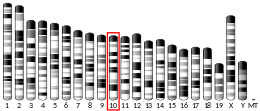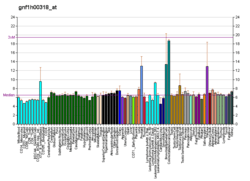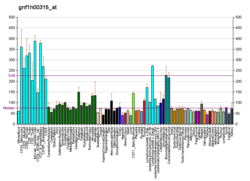NDUFA12
NADH dehydrogenase [ubiquinone] 1 alpha subcomplex subunit 12 is an enzyme that in humans is encoded by the NDUFA12 gene.[5][6][7] The NDUFA12 protein is a subunit of NADH dehydrogenase (ubiquinone), which is located in the mitochondrial inner membrane and is the largest of the five complexes of the electron transport chain.[8][9] Mutations in subunits of NADH dehydrogenase (ubiquinone), also known as Complex I, frequently lead to complex neurodegenerative diseases such as Leigh's syndrome that result from mitochondrial complex I deficiency.[7]
Structure
The NDUFA12 gene is located on the q arm of chromosome 12 in position 22 and spans 32,386 base pairs.[7] The gene produces a 17 kDa protein composed of 145 amino acids.[10][11] NDUFA12 is a subunit of the enzyme NADH dehydrogenase (ubiquinone), the largest of the respiratory complexes. The structure is L-shaped with a long, hydrophobic transmembrane domain and a hydrophilic domain for the peripheral arm that includes all the known redox centers and the NADH binding site.[8] It has been noted that the N-terminal hydrophobic domain has the potential to be folded into an alpha helix spanning the inner mitochondrial membrane with a C-terminal hydrophilic domain interacting with globular subunits of Complex I. The highly conserved two-domain structure suggests that this feature is critical for the protein function and that the hydrophobic domain acts as an anchor for the NADH dehydrogenase (ubiquinone) complex at the inner mitochondrial membrane. NDUFA12 is one of about 31 hydrophobic subunits that form the transmembrane region of Complex I, but it is an accessory subunit that is believed not to be involved in catalysis.[12] The predicted secondary structure is primarily alpha helix, but the carboxy-terminal half of the protein has high potential to adopt a coiled-coil form. The amino-terminal part contains a putative beta sheet rich in hydrophobic amino acids that may serve as mitochondrial import signal.[7][9][13]
Function
The human NDUFA12 gene codes for a subunit of Complex I of the respiratory chain, which transfers electrons from NADH to ubiquinone.[7] NADH binds to Complex I and transfers two electrons to the isoalloxazine ring of the flavin mononucleotide (FMN) prosthetic arm to form FMNH2. The electrons are transferred through a series of iron-sulfur (Fe-S) clusters in the prosthetic arm and finally to coenzyme Q10 (CoQ), which is reduced to ubiquinol (CoQH2). The flow of electrons changes the redox state of the protein, resulting in a conformational change and pK shift of the ionizable side chain, which pumps four hydrogen ions out of the mitochondrial matrix.[8]
Clinical significance
Mutations to NDUFA12 are not frequently found to cause complex I deficiency on their own. NDUFA12 is an accessory subunit and the complex can still be found assembled and enzymatically active in its absence, though in reduced amounts and activity. However, a cytosine to tyrosine mutation at position 178 that leads to a premature stop codon has been found in place of arginine at amino acid 60, leading to delayed early development, loss of motor abilities, and basal ganglia lesions typical of Leigh's syndrome.[14]
References
- GRCh38: Ensembl release 89: ENSG00000184752 - Ensembl, May 2017
- GRCm38: Ensembl release 89: ENSMUSG00000020022 - Ensembl, May 2017
- "Human PubMed Reference:". National Center for Biotechnology Information, U.S. National Library of Medicine.
- "Mouse PubMed Reference:". National Center for Biotechnology Information, U.S. National Library of Medicine.
- Triepels R, Smeitink J, Loeffen J, Smeets R, Trijbels F, van den Heuvel L (Apr 2000). "Characterization of the human complex I NDUFB7 and 17.2-kDa cDNAs and mutational analysis of 19 genes of the HP fraction in complex I-deficient-patients". Human Genetics. 106 (4): 385–391. doi:10.1007/s004390000278. PMID 10830904.
- Skehel JM, Fearnley IM, Walker JE (Nov 1998). "NADH:ubiquinone oxidoreductase from bovine heart mitochondria: sequence of a novel 17.2-kDa subunit". FEBS Letters. 438 (3): 301–305. doi:10.1016/S0014-5793(98)01317-9. PMID 9827566.
- "Entrez Gene: NDUFA12 NADH dehydrogenase (ubiquinone) 1 alpha subcomplex, 12".
- Voet D, Voet JG, Pratt CW (2013). "Chapter 18". Fundamentals of biochemistry: life at the molecular level (4th ed.). Hoboken, NJ: Wiley. pp. 581–620. ISBN 978-0-470-54784-7.
- Emahazion T, Beskow A, Gyllensten U, Brookes AJ (Nov 1998). "Intron based radiation hybrid mapping of 15 complex I genes of the human electron transport chain". Cytogenetics and Cell Genetics. 82 (1–2): 115–9. doi:10.1159/000015082. PMID 9763677.
- Zong NC, Li H, Li H, Lam MP, Jimenez RC, Kim CS, Deng N, Kim AK, Choi JH, Zelaya I, Liem D, Meyer D, Odeberg J, Fang C, Lu HJ, Xu T, Weiss J, Duan H, Uhlen M, Yates JR, Apweiler R, Ge J, Hermjakob H, Ping P (Oct 2013). "Integration of cardiac proteome biology and medicine by a specialized knowledgebase". Circulation Research. 113 (9): 1043–53. doi:10.1161/CIRCRESAHA.113.301151. PMC 4076475. PMID 23965338.
- "NDUFA12 - NADH dehydrogenase [ubiquinone] 1 alpha subcomplex subunit 12". Cardiac Organellar Protein Atlas Knowledgebase (COPaKB).
- "NDUFA12". UniProt.org. The UniProt Consortium.
- Ton C, Hwang DM, Dempsey AA, Liew CC (Dec 1997). "Identification and primary structure of five human NADH-ubiquinone oxidoreductase subunits". Biochemical and Biophysical Research Communications. 241 (2): 589–94. doi:10.1006/bbrc.1997.7707. PMID 9425316.
- Ostergaard E, Rodenburg RJ, van den Brand M, Thomsen LL, Duno M, Batbayli M, Wibrand F, Nijtmans L (Nov 2011). "Respiratory chain complex I deficiency due to NDUFA12 mutations as a new cause of Leigh syndrome". Journal of Medical Genetics. 48 (11): 737–40. doi:10.1136/jmg.2011.088856. PMID 21617257.
Further reading
- Maruyama K, Sugano S (Jan 1994). "Oligo-capping: a simple method to replace the cap structure of eukaryotic mRNAs with oligoribonucleotides". Gene. 138 (1–2): 171–174. doi:10.1016/0378-1119(94)90802-8. PMID 8125298.
- Suzuki Y, Yoshitomo-Nakagawa K, Maruyama K, Suyama A, Sugano S (Oct 1997). "Construction and characterization of a full length-enriched and a 5'-end-enriched cDNA library". Gene. 200 (1–2): 149–156. doi:10.1016/S0378-1119(97)00411-3. PMID 9373149.
- Gubin AN, Njoroge JM, Bouffard GG, Miller JL (Jul 1999). "Gene expression in proliferating human erythroid cells". Genomics. 59 (2): 168–177. doi:10.1006/geno.1999.5855. PMID 10409428.
- Hu RM, Han ZG, Song HD, Peng YD, Huang QH, Ren SX, Gu YJ, Huang CH, Li YB, Jiang CL, Fu G, Zhang QH, Gu BW, Dai M, Mao YF, Gao GF, Rong R, Ye M, Zhou J, Xu SH, Gu J, Shi JX, Jin WR, Zhang CK, Wu TM, Huang GY, Chen Z, Chen MD, Chen JL (Aug 2000). "Gene expression profiling in the human hypothalamus-pituitary-adrenal axis and full-length cDNA cloning". Proceedings of the National Academy of Sciences of the United States of America. 97 (17): 9543–9548. Bibcode:2000PNAS...97.9543H. doi:10.1073/pnas.160270997. PMC 16901. PMID 10931946.
- Murray J, Taylor SW, Zhang B, Ghosh SS, Capaldi RA (Sep 2003). "Oxidative damage to mitochondrial complex I due to peroxynitrite: identification of reactive tyrosines by mass spectrometry". The Journal of Biological Chemistry. 278 (39): 37223–37230. doi:10.1074/jbc.M305694200. PMID 12857734.
This article incorporates text from the United States National Library of Medicine, which is in the public domain.






